- © 2025 Annapolis Home Magazine
- All Rights Reserved
By Robert Haywood and Kymberly Taylor
Introduction by Robert Haywood
Photography by Tony Lewis Jr.
Historical images courtesy of Historic Annapolis, Inc.
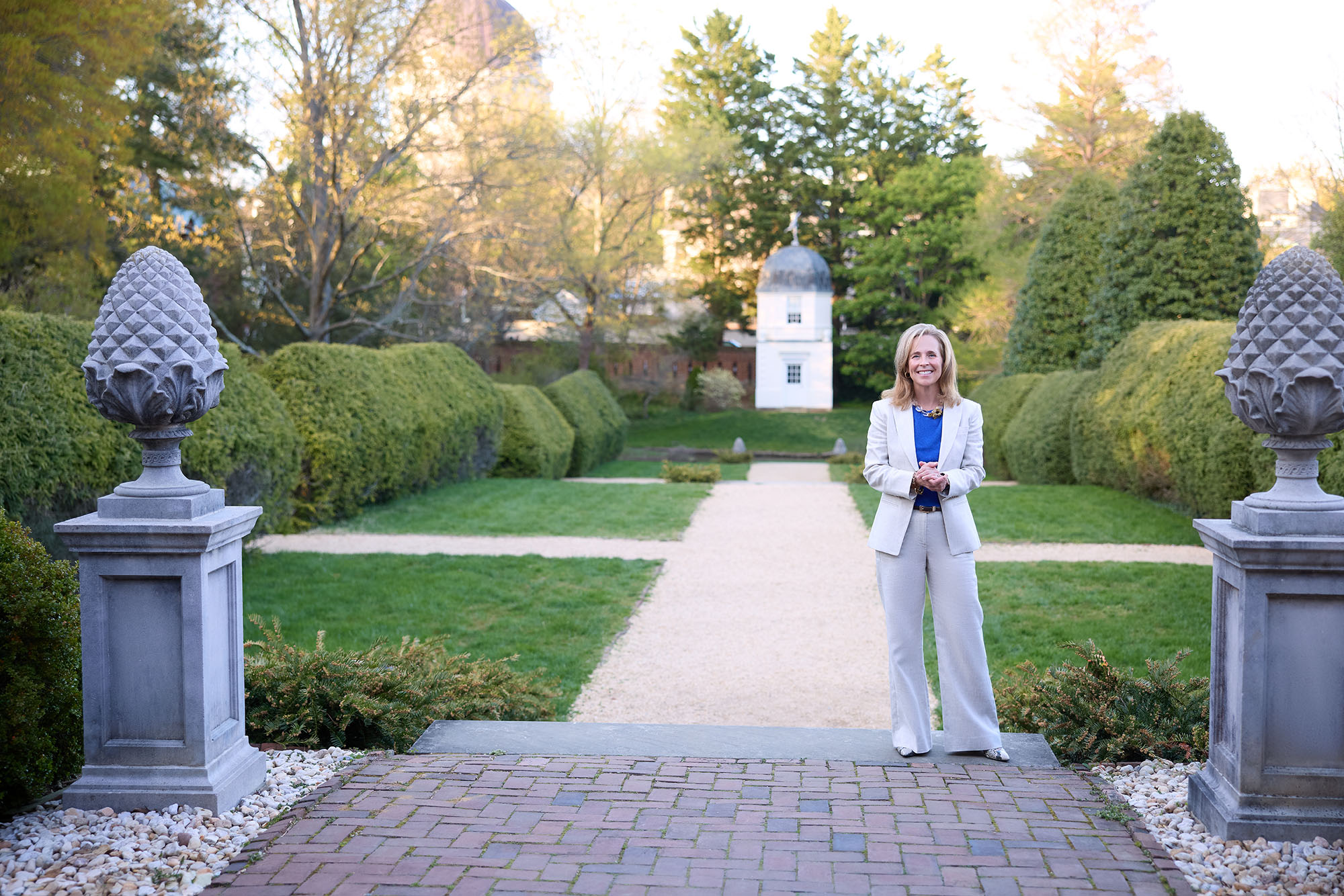
Historic Annapolis, Inc. is far more than an organization offering tours of period rooms and the grounds of 18th-century mansions. The tours, along with the concerts, lectures, and more, are the part that we, the public, get to enjoy. The homes also provide us with a concrete sense of history. Behind these architectural structures and related programs are the mighty efforts to preserve historic homes and buildings in the first place.
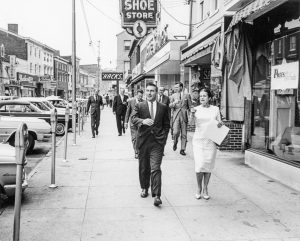
St. Clair Wright points out historic buildings on lower Main Street to Secretary of the Interior Stewart Udall on July 7, 1965. Udall was in Annapolis to recognize the historic district as a Registered National Historic Landmark. (M.E. Warren, 1965). Caption: Maryland State Archives
Anne St. Clair Wright, a volunteer, was the driving force behind Historic Annapolis’ beginnings when it was founded in 1952. She believed it was urgent to prevent City Dock from being encased by high-rise buildings. This required the city to establish a zoning code for a downtown historic district. Wright inspired roughly 200 citizens to join and establish Historic Annapolis.
Over the years, many individuals have worked tirelessly to persuade, advocate, write letters, attend meetings and hearings, and fundraise—all in the service of preserving the past for those living in the present and beyond.
Wright’s visionary leadership continues today with Karen Brown, the current President and CEO of Historic Annapolis, Inc. Like Wright, Brown and her team are at the forefront of preservation efforts. Today, their attention is focused, in part, on the Captain Burtis house (c. 1878-85), the sole surviving waterman’s cottage on City Dock. The humble Burtis house is also significant for the city’s history because it demonstrates a lifestyle and labor wholly different from that of the gentry who built the nearby 18th-century mansions. HA asserts that the Burtis house will be overwhelmed by a proposed Maritime Welcome Center attached to the house that is nearly twice the size of the home. (These discussions are intricate, as is the debate on whether the proposed Center is attached to the house or an independent structure. However, these arguments can’t be sufficiently outlined here.)
Along with Historic Annapolis’ advocacy ventures are its campaigns to build collections that spotlight life in Annapolis throughout its history. When we first met with Karen, she was thrilled to share that HA had recently acquired at auction with the Maryland Center for History and Culture two 18th-century silver drinking vessels known as canns (i.e., mugs). But beyond their antique status, why the excitement?
We understand history through stories and objects—objects like these canns. Even small things help us situate ourselves in time. Here we are in 2025, holding vessels that were crafted in 1763. Made in England and then shipped to Colonial Annapolis, the canns showcase the fine craftsmanship of early English silversmiths.
Colonial history, which these canns represent, is a central part of our nation’s story and shapes our distinct identity as Americans. It’s also essential to the identity of Annapolis and its civic pride as a “historic city.” This history, embodied by the canns, reflects a place marked by stark class and racial differences—the wealth implied by these refined objects and the enslaved laborers who would have cared
for them.
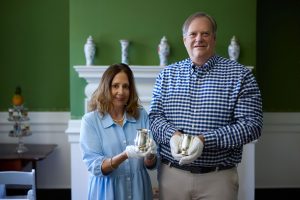
Robert Haywood and Kymberly Taylor are pictured holding the canns (or drinking mugs) that originally belonged to Declaration signer William Paca and his wife, Mary. The canns are jointly owned by Historic Annapolis, Inc. and the Maryland Center for History and Culture. Photograph by Tony Lewis Jr.
The canns belonged to William and Mary Paca, were created the year of their marriage, and were engraved with the monogram “WMP.” William Paca was a signatory of both the Continental Association and the United States Declaration of Independence. He served as a Maryland delegate to the First and Second Continental Congresses and was the third governor of Maryland.
The canns are now displayed in Paca’s downtown Annapolis home, a five-part Georgian mansion built for the Paca family, a home whose construction began in the same year as the canns, 1763. As important as this renovated home is as a representation of 18th-century architecture and life, it holds a prominent place in the modern cityscape of downtown Annapolis.
With respect for all those committed to preservation over many decades, we invited Karen Brown to appear as our cover story for The Faces of Annapolis 2025. Brown stepped into this crucial role following a decade of effective leadership by Robert Clark. We sat down in Brown’s office at the Shipley House to discuss her work and the challenges she faces.
During our photoshoot at the Paca House and Gardens, Karen invited us to hold the canns. After donning white protective cloth gloves, we were surprised by the delicacy and lightness of the canns as we held and examined them. We imagined the very long life they have lived and the distances they have traveled.
A city like Annapolis, where the hard work of historic preservation is central to its identity, is nothing to take for granted. It can be lost, but historic preservation is pivotal to what makes Annapolis an exceptional place to live and visit, as well as to what makes the city so vital to the history of the United States.
– Robert Haywood
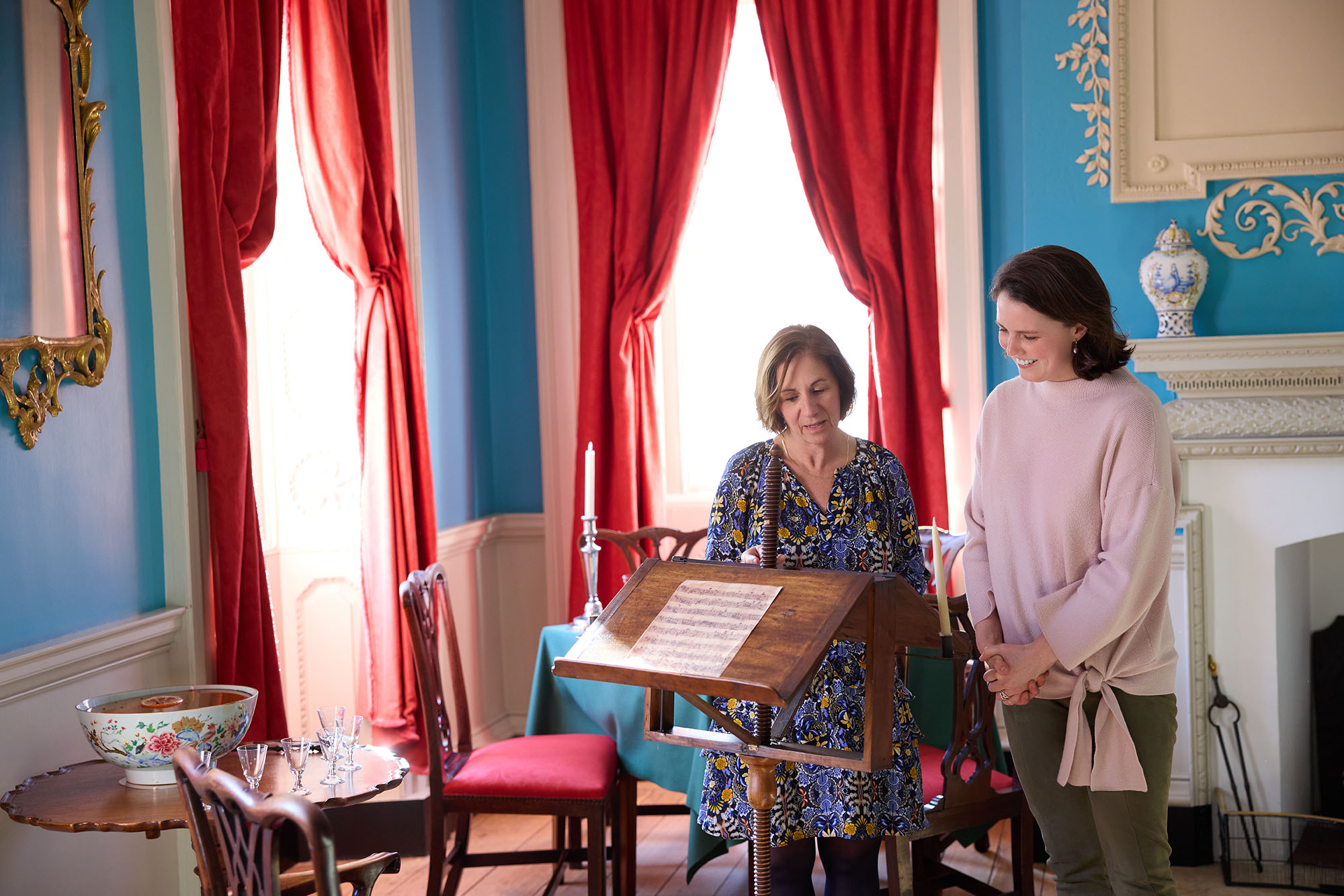
Mary-Angela Hardwick, Vice President of Education and Interpretation, Elizabeth Fox, Curator, Historic Annapolis, Inc.
The following interview has been edited for brevity and clarity.
Kymberly Taylor: How did you become involved in Historic Annapolis, Inc., and what do you see as its future?
Karen Brown: I have been with Historic Annapolis for nine years now. I came from the City of Annapolis. I was in the Historic Preservation division in the Department of Planning and Zoning and then came over here to run the Preservation division. And just about two and a half years ago, I was promoted to president and CEO of the organization. Prior to working with the city, I worked for the Federal Advisory Council on Historic Preservation.
Robert Haywood: How did Historic Annapolis get started, and what is its role today?
Brown: Historic Annapolis grew out of a grassroots effort in the 1950s to preserve Annapolis’s architectural legacy. And for close to 75 years, Historic Annapolis has been instrumental in saving or protecting historic buildings throughout the Historic District. We’ve helped block outsized new construction that would have distracted from the city’s historic character and unique charm. Also, throughout the course of our history, we have researched and interpreted the diversity of Annapolis’s history through collecting documents, objects, and photographs that embody that history. An important component of who we are is that we have a unique public-private partnership with the State of Maryland in which we manage, maintain, and operate a dozen historic properties on behalf of the State and publicly present them to people to enjoy, to learn from, to live with, and to be inspired by.
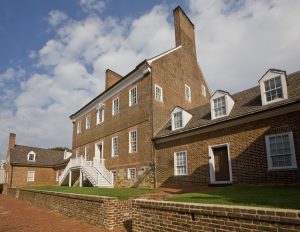
James Brice House, 42 East Street, Annapolis
Work began on the Brice House in
April 1767 with the laying of a cornerstone marked “The Beginning.” The house is currently undergoing extensive restoration by an expert team of craftsmen and conservators. Photograph by Geoffrey Hodgdon.
Haywood: What are some of those properties?
Brown: Some of our most noteworthy properties in our portfolio are the William Paca House & Garden, which was built between 1763 and 1765 and is a national historic landmark. Another is the James Brice House. That came to our portfolio in 2016 and is also a national historic landmark. Other properties are smaller and more vernacular, such as the Shiplap House—the oldest frame building in Annapolis that dates to 1715. Other ones that are open to the public are the Hogshead Trades Museum and the Waterfront Warehouse. And then we have several properties that we sublease for commercial use. And then we also have another important property in our portfolio, 99 Main Street, which is home to the Museum of Historic Annapolis.
Haywood: So, all of these are part of the private-public partnership with the State?
Brown: A dozen of those properties. The one we own outright is 99 Main, which houses the Museum of Historic Annapolis.
Taylor: Just to back up a minute, you mentioned public-private partnerships. Can you clarify what this means?
Brown: Well, public-private means that Historic Annapolis is partnering with the state of Maryland. It’s unique. In fact, we haven’t really seen a model of this capacity or magnitude anywhere else. We have over 50,000 square feet of buildings and two acres of green space. So, they’re public assets that Historic Annapolis manages on behalf of the state. It’s governed under a long-term master lease agreement. And the language is that we maintain, manage, and operate them on behalf of the State.
Haywood: Let’s go back to the role of Historic Annapolis today and how it has evolved over the years.
Brown: So, we are closing in on 75 years, if you can believe it. Our tagline is, “Preserve, protect, and connect,” preserving and protecting our cultural heritage and crafting engaging ways to connect with that heritage. We do it as preservationists and as advocates, educators, and storytellers.
We operate multiple museums in the heart of the Historic District. And we are also very involved in policy and regulatory issues that pertain to historic properties in Annapolis. We offer over 100 public programs annually if you can believe it. We welcome over 200,000 visitors annually to our sites. We have robust educational programs and group tours for school children throughout this county and throughout the state.
What I really see for this future is perhaps the most impactful chapter in the history of the organization. And I’m very proud to be leading it.
The reason why I think it’s impactful is, first of all, we have an incredible group of professionals who are working here and carrying out our mission. It’s an interesting time in the history of our country, building up to the national celebration of the semi-quincentennial, the 250-year anniversary of the founding of our nation. And then, we are getting closer to our 75th anniversary, which will be in 2027. So, Historic Annapolis is one of the oldest, most established historic preservation organizations in the country.
Haywood: Can you tell us what the Brice House renovation entails?
Brown: The Brice House, a national historic landmark, is an extraordinary building, and it’s significant for a number of reasons. First, it possesses what we say is a high degree of integrity, meaning it has a lot of its original building fabric and materials that date to its 1774 construction period. 250 years. Second, James Brice kept a ledger book that meticulously recorded the construction of the building. And so, we’ve got this incredible primary document that is helping guide that restoration. And the third piece is that we have assembled an incredible group of consulting architects, craftsmen, and masons. Historic masons are restoring it using those same traditional materials and techniques. Oftentimes, the secondary spaces have been changed, where mechanical systems have been introduced. And we are doing a full state-of-the-art restoration of the entire building, from the cellar to the attic, from wing to wing, to show a true full restoration of even those secondary spaces.
We are turning all the lights on and telling all the stories of not just the Brice family themselves but also the enslaved persons who lived and moved and operated through the house. And also the tradespeople and the craftspeople whose continuity of craft we are continuing today. So, it’s phenomenal.
Taylor: So, it’s another jewel set in the crown of Annapolis?
Brown: Absolutely. And it really is, again, the house is kind of unifying our campus, tying those two buildings together. But it is different in that Paca House and Gardens are a reconstruction of a lot of original materials, whereas Brice is original material that we’re restoring.1
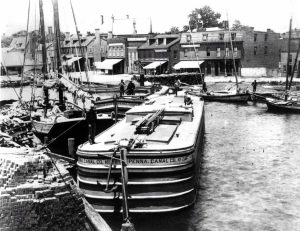
A late 19th-century photograph of the historic working waterfront that is now home to the recreational and tourism activities of City Dock’s “Ego Alley.” Seen in the background (left to right) are the Market House, Shiplap House, Middleton Tavern, and the row of Dock Street commercial buildings southeast of Randall Street. The tall, steep roofs of the James Brice House and the St. Anne’s Mission Chapel are visible in the distance (left of center).
Haywood: How are Historic Annapolis and the Historic District distinct from all the other historic districts in the US? What makes this historic district special?
Brown: Yes, it is very special. Annapolis is a national treasure. And it is extraordinary for several reasons. First, it’s a very historic community—from George Washington’s resignation to the Maryland State House, which is the oldest in continuous use.
We have four Maryland signers’ homes that are still extant and within steps from City Dock, the heart of the Historic District. Second, I think it is special because of its long-standing commitment to preservation. It is the largest assembly of 18th-century masonry buildings in the country.
It’s an incredible assembly of four centuries of architecture. And I think that the buildings provide a sense of continuity; they’re beacons of the past and witnesses to our past. This historic fabric of the community provides a sense of cultural identity that is really grounding. And again, it provides sort of this sense of stability in our ever-changing world.
Taylor: So, what are the biggest challenges you’re facing in preserving the historic character of downtown Annapolis?
Brown: I would say one of the most significant challenges that we’re facing today is the idea of resiliency. Sea level rise, land subsidence, extreme weather events, and really protecting our fragile coastal landscape. I think that adaptation is key, and I think that is a priority of this city administration, and it is something that is very important for the future of our historic core.
Now, it’s also worth noting that Annapolis is a city under constant pressure from development. Cities continually evolve and change over time. And part of what we work to do is help manage that change in such a way that it protects the historical integrity and character of our historic core. New development should complement and not compete with its historic surroundings.
A historic community doesn’t look this way by accident. It takes constant and active preservation and advocacy to keep Annapolis looking the way it does.
Haywood: I know it does. It would be gone in a week without such advocacy and preservation efforts. How does this relate to Historic Annapolis’s perspective on the ongoing transformation of City Dock?
Brown: Historic Annapolis has played a leading role in the City Dock Action Committee and the planning for City Dock redevelopment since the National Trust for Historic Preservation placed Annapolis on the 11 most endangered list.2
Due to a proposal for overscale development, and out of this powerful, open, citizen-based planning effort, came a consensus plan for the future of City Dock. I think that’s the simplest way to explain it.
Haywood: A consensus consisting of who?
Brown: A number of stakeholders. It was a very robust outreach among community stakeholders to come up with a plan to enhance the Historic District in a way that was resilient within a preservation context.
What we challenge is [the city’s] departure from that consensus plan, most notably the proposal for the Maritime Welcome Center.3 The Maritime Welcome Center is proposed to be located on the water’s edge and attached to the sole surviving historic property in the study area, which is the Captain William Burtis House. It’s significantly larger than the building it’s attached to. We currently have a legal challenge [i.e., a judicial review] relating to the Historic Preservation Commission’s decision to approve this building.4
Our appeal is about a fair and consistent application of well-established preservation standards and guidelines, which exist to protect the Historic District. It really is about the future integrity of our historic core. The city is calling it the Maritime Welcome Center, and it’s attached to the Captain William Burtis House. It’s not deferential. It overwhelms the historic structure by size, width, and scale—it’s twice as big. It monopolizes that structure. And our position is that that is the sole surviving historic waterman’s home on the water’s edge in the district. It’s the last man standing, and it deserves to be celebrated.
Haywood: So, how can people who care about Historic Annapolis support its work?
Brown: We are a charitable nonprofit. And we are a membership-based organization, so we invite people to become members. We also have a robust community of volunteers who help us with much of our work. For instance, our annual Mother’s Day plant sale.
Taylor: I love that. That’s one of my favorite things.
Brown: A volunteer army cultivates and propagates these plants year-round, and it’s a wonderful fundraiser for Historic Annapolis. So, you can get involved by volunteering as a docent or helping us with our museums or our gardens. You can also get involved by coming to some of our programs and being part of our community. We offer over 100 public programs per year.
Something I also want to mention is that I’m a collaborator. I love that African proverb, “If you want to go fast, go alone. If you want to go far, go together.”
1 In addition to the Paca and Brice Houses, both managed by Historic Annapolis, Inc., the other major 18th-century mansion open to the public is the Hammond Harwood House. The Hammond Harwood is independent of Historic Annapolis, Inc., but all three are significant parts of the fabric of the Annapolis historic district. • 2 See https://savingplaces.org/places/annapolis • 3 For the City of Annapolis’ City Dock Project, information on the City Dock Action Committee, and a timeline, visit https://accessannapolis.com/ • 4 The Historic Preservation Commission is separate from Historic Annapolis, Inc. The HPC is part of the City of Annapolis, and its members are appointed by the Mayor. For information on the HPC, visit annapolis.gov/1381/Historic-Preservation-Commission
For more information on about all the properties Historic Annapolis, Inc. owns or manages visit, www.annapolis.org
© Annapolis Home Magazine
The Faces of Annapolis 2025